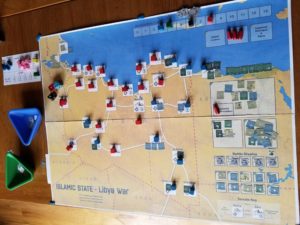This game is published by One Small Step Games (OSS) in Counterfact Magazine. I downloaded it from Wargame Vault. It is solitaire, the contemporary topic is of some interest, and the format seemed to lend itself to download and DTP construction. The forum section of the game’s Boardgamegeek page is essential reading as are the revised rules found at OSS’s game page.
The map printed out fine and looks good. The counters were difficult to cut because the colors of the various factions’ units are similar shades of drab and lack visible guide lines. The result was a grotesque lack of uniformity. I decided to use Risk blocks in lieu of some of the counters/chits. This improved appearances.
The game’s topic is the war against Daesh in Libya. Allied forces are tasked with controlling key cities and oil fields as portrayed on the point-to-point map. Each of the game’s eight turns is broken down into five (or six based on a turn-end roll), IGO-UGO action rounds. Victory is determined by how many areas Daesh controls, number of active leaders, negative press coverage (due to collateral damage) received by the Allies, and hostages and downed pilots executed.
Allied forces can perform any one of several actions during their phase. These are conventional unit movement into a Daesh controlled hex which triggers combat, “snatch and grab” operations using special forces to seize Daesh leaders for interrogation or hostages, landing (amphibious) operations, heli-borne assault, reconnaissance, and strike missions with aircraft.
Daesh actions are generated using a table listing ten possible actions including kidnapping, terrorist attacks, and sabotage.
Combat is performed on a display arraying Allied units against a Daesh counterpart randomly drawn from the Daesh force pool. Each Allied unit can be supported by aviation, drone or artillery assets. Allied forces never eliminate their opponents. A positive combat result will have the Daesh unit ineligible to be activated again during the current turn, or unable to return to the Daesh unit pool until after the next game turn. Intelligence concerning the whereabouts of hostages or Daesh leaders can also result from combat. Any Daesh force that survives an attack “fires back” at their opponent and, in certain situations there is a combat modifier due to special weaponry. These units are returned to the force pool.
Here’s an imaginatively framed shot of the game in-progress.

I used traditional blue and red blocks to identify friendly and Daesh controlled areas instead of counters. At bottom right is the combat display. Both types of Allied units (combat on top and support at bottom) can fire at Daesh units. The Allied force pools are located above the combat display. The red lozenges are for Daesh leaders. I substituted pink blocks for the hostage counters, blue lozenges for pilots and a yellow block for media. These were placed on a hand scribbled holding area card, which also had the turn phase track. Daesh victory points were tracked by a red block, allied casualties by a blue block and collateral damage by a black block. Turns were marked with another green block, along with stacks of destroyed Daesh counters by a result calling for their re-entry to the force pool sometime later in the game. The containers were used to hold conventional Allied units not on the map, and the Daesh force pool. Support units can be used only once per game turn. In the absence of specific guidance I treated parachute and special forces units as support units since it would take some time to re-brief, re-organize these types of specialized units.
The rules were criticized in a now-deleted post over at Boardgamegeek. I would say that the layout could be better, perhaps more along the lines of the solitaire Destruction of Force Z, which presented the rules and, most importantly, charts in game turn sequence. After flipping back and forth between Islamic State’s eight pages, I did a cut-and-paste to reduce the rules to a manageable, more sequential and flippable four pages. Unlike the redacted reviewer, I cannot see playing the game in 60 minutes or less. Not a bad thing, but there are too many moving parts. Still, the pace is brisk with plenty of decisions and actions in every turn.
In my game the Allies lost by Turn 5, probably due to my misreading of the collateral damage rules. The Combat rules section indicates that collateral damage should be checked after combat – but is that individual combat or turn phase combat? The Collateral Damage table indicates after all turn phase combats have been completed. The latter significantly reduces the potential point gain for Daesh.
I enjoyed the game, and don’t regret the cost of purchase, time taken to construct the components, and understand the rules. It is an intriguing system. For me, on a cost-benefit basis, the returns on investment seem marginal. I don’t imagine replaying it right now, or in the near future. For someone else, this might be a go-to game, but not for me.
